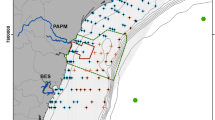Abstract
Sand beaches and spits of the southern embankment of the inner Tagus estuary indicate the influence of locally generated wind waves. The aim of this study is to evaluate the ability of these waves to resuspend bottom sediments, and sustain the longshore transport. For this purpose, local wave climates were obtained by running a wave forecasting numerical model for three selected target areas.
Results suggest that local wave climate is largely responsible for sand movement and accumulation in the marginal zones of the inner estuary facing the longest effective fetch. Two main areas of longshore transport were identified in the inner Tagus estuary with similar annual gross transport rates, of about 12 000 m3 yr−1. Results obtained for the annual net drift amount and direction are in agreement with geomorphology and accretion direction of the beaches. Wave-induced longshore transport rates agree with field observations and erosional evolution of the Alfeite sand beach during the last century.
Similar content being viewed by others
References
CERC (1984) Shore protection manual. U.S. Army Corps of Eng. Res. Center, U.S. Govt., Washington D.C.
Covas JA and Fortes CJ (1989) Mathematical model for wind-wave forecasting. LNEC Report No. 252/89-NPP, Laboratório Nacional de Engenharia Civil, Lisbon, pp. 1–215 (in Portuguese)
Earle MD and Bishop JM (1984) A practical guide to ocean wave measurements and analysis. Endeco Inc., Marion, MA, USA, pp. 1–78
Freitas MC, Andrade C, Moreno JC, Munhá JM and Cachão M (1999) The sedimentary record of recent (last 500 years) environmental changes in the Tagus marshes, Portugal. Geologie en Mijnbouw (in press).
Galvin CJ (1967) Longshore current velocity: a review of theory and data. Rev of Geophys 5(3): 287–304
Hurdle DP and Stive RJH (1989) Revision of SPM 1984 wave hind-cast model to avoid inconsistencies in engineering applications. Coastal Eng 12: 339–351
Komar PD (1976) Beach processes and sedimentation. Prentice-Hall, Inc., Englewood Cliffs, New Jersey
Komar PD (1977) Beach sand transport: distribution and total drift. J Water Port, Coastal and Ocean Division (ASCE), 103,WW2: 225–239
Komar PD and Inman DL (1970) Longshore sand transport on beaches. J Geophys Res 75(30): 5514–5527
Lousada C (1995) Contribution for the study of sand sediments provenance of Tagus estuary left embankment beaches. Faculdade de Ciências da Universidade de Lisboa, pp. 1–76, unpublished Report (in Portuguese)
Mendes DC and Coelho MF (1989) Potentiality of aeolian energy. Preliminary studies-v.1. Meteorological and Geophysical Monographs, No. 13, Instituto de Meteorologia, Lisbon, pp. 1–264 (in Portuguese)
Nordstrom K (1992) Estuarine beaches. Elsevier Science Publishers, Ltd, New York
Roman CT and Nordstrom K (1996) Environments, processes and interactions of estuarine shores. In: K. Nordstrom, C. Roman, Eds, Estuarine shores. Evolution, environments and human alterations. Wiley, Chichester, pp. 1–12
Seymour R (1977) Estimation wave generation on restricted fetches. J Water Port, Coastal and Ocean Division (ASCE), 103,WW2: 251–264
Author information
Authors and Affiliations
Rights and permissions
About this article
Cite this article
Freire, P., Andrade, C. Wind-induced sand transport in Tagus estuarine beaches – First results. Aquatic Ecology 33, 225–233 (1999). https://doi.org/10.1023/A:1009911012260
Issue Date:
DOI: https://doi.org/10.1023/A:1009911012260




